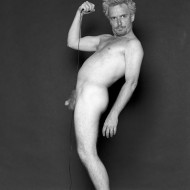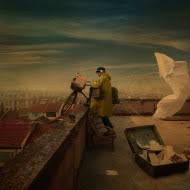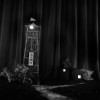
© Paul Turounet
Paul Turounet long term project “Estamos Buscando A – We’re Looking For” explores the cultural and emotional concerns of Mexican emigrants that are trying to cross the United States border. It is a really engaged and personal body of work, as Paul Turounet says: “like the migrants, I too, have been on a personal journey to a place where I’ll be in a place I can call home“.
In this article Paul Torounet show us a page from his journal that describe his experience in the middle of the desert, a long mail from a U.S. Border Patrol Agent and a description of his photographic installation Más allá – the Retablos of Migrants along the U.S. – Mexico Border
Following text and photos by Paul Turounet.
Estamos Buscando A – We’re Looking For
“Pobre Mexico! Tan lejos de Dios y tan cerca de los Estados Unidos.”
“Poor Mexico! So far from God and so close to the United States.”Mexican President Porfirio Diaz (1877 – 1910)

© Paul Turounet
Since 1992, the U.S. Border Patrol has apprehended nearly 1.5 million undocumented persons attempting to enter the southern border from Mexico each year. During this time, the U.S. Department of Homeland Security has dramatically increased its law enforcement presence along the nearly 2,000 mile border. It’s hard to imagine anyone could make it past such a formidable barrier. Yet, Mexican and Central American migrants endure the journey and miraculously make it across despite the risks and dangers.
So why would so many men, women and children attempt to risk and sacrifice so much to come to the United States? To unite with family already there? Economic desperation and necessity? A restless spirit and the need to find emotional harmony? There is no universal reason other than the need to go from one place to another both literally and metaphorically; a need universal to existence and the human experience.

© Paul Turounet
With the support of a Fulbright Fellowship and grants from the Trans-Border Institute, I’ve been photographing the social and cultural conditions of the Mexican experience on the U.S. – Mexico Border while living on both sides of the border. I’ve been drawn to the border light, which has served as a beacon of hope for those desiring to go North. And like the migrants, I too, have been on a personal journey to a place where I’ll be in a place I can call “home;” a place where I’ll be resolved with my own sense of identity, purpose and values as well as provide others the opportunity to contemplate our collective spiritual needs to get to that place we all desire.
Regardless of the demarcation lines of country and culture, we are all migrants in search of something profound and meaningful to our being. The bright border light forces a pause in this transitory experience for the migrant. At that very moment, their faces intimately reveal an unsettling and knowing sense that something is being lost and sacrificed in anticipation of something gained once nightfall finally arrives.
June 24, 2004 – Traveling with Grupos Beta (Mexican Border Patrol)
It takes about an hour to drive south from Tucson to Sasabe. I’ve been staying in Tucson, as there’s only one hotel in Sasabe and it’s usually filled with migrants. It would be too dangerous to stay there anyway. Sasabe feels like the wild west only the guns aren’t visible.
Crossing the border, it takes a while to convince the Mexican Customs agent why I’m going to Sasabe. He’s right, there’s nothing there, “Just a bunch of Mexicans looking to escape.” After he goes through my gear, I make some pictures of the agent and put the Polaroid negatives in my jar of sodium thiosulfate. He was really curious about what the soup jar full of liquid was for.
For the past few days, I’ve been traveling with Grupos Beta, the Mexican Border Patrol for the Protection of Migrants. They don’t have any law enforcement jurisdiction and are not allowed to carry firearms – even though many of the human and drug smugglers are packing a full arsenal of weapons. There are four agents stationed at the Grupos Beta office in Sasabe and they can only travel along the border to advise migrants of the dangers of crossing and register minors who are attempting to cross.

© Paul Turounet
Since the motorcycle kept getting stuck in the sand, and I was slowing them down on their quad-runners, it’s decided we’ll travel by truck to Rancho La Sierrita, which is about 20 miles west of Sasabe. Before heading out, we stop at the Super Coyote Market to get some water and mix it with orange-flavored powder for a cheap version of orange juice.
Just south of town, we drive through La Ladrillera – “The Brickyard” – an old brick-making area that has been converted into a one-stop migrant transit center where nearly all the migrants come from Altar to make travel plans to cross the border. In the afternoon, once trucks are loaded full with migrants, they travel out it into the desert – both east and west – to drop migrants at isolated crossing points. Parked is a brand new, red Ford Lobo (F-150), which makes Felipe and Jaime, the Grupos Beta agents, nervous. “We don’t stop when the truck is here. Too dangerous.”
Along the way to Rancho La Sierrita, we stop at Arroyo de Coyote. It is the middle of the day and already hot. There’s no breeze – just the buzzing of flies everywhere. Everything is still in the desert. There are two large arroyos that have been created over time from the monsoon rains that take place every summer. Both are filled with clothes and other personal effects – pants, shirts, backpacks, underwear. Arroyo de Coyote is where migrants are robbed and the women are sexually assaulted.
Rancho La Sierrita is in the middle of nowhere, about a mile south of the border. It’s a place where migrants come to wait – wait to meet up with a coyote, wait for nightfall, wait to be smuggled across the barbed wire fence, wait for the unknown. There’s nothing here except a couple of little shacks where migrants can pick up supplies before making their journey north at nightfall.
We stop at Puerto San Miguel, another small migrant camp, and pick up nine women and three children who had been abandoned by their coyote the night before. One of the women is six-months pregnant. They want to go back to La Ladrillera so they can find another coyote to take them across. As we travel east back to Sasabe, it seems we’re passing trucks with full loads heading west every fifteen minutes. How can so many people be crossing every day?
As we approach La Ladrillera, the red truck is still there. We stop at the edge of the brickyard and drop the women and children off. Felipe tries to persuade them to return to town, but they insist on trying to cross. The dangers and uncertainty of their journey and the possibility of making it across outweighs returning home.
Heading back to my cheap hotel room in Tucson, I think about what I’ve seen. Riding a motorcycle, especially through the desert, provides for quite a bit of time to be with one’s thoughts. My head feels like it’s going to explode in my helmet. It’s so hot.
August 10, 2004 – Email from U.S. Border Patrol Agent
Dear Paul
Just a quick note to thank you again for helping out with the alien that you found on the side of Highway 286. I just wanted to let you know the resolution of what happened that day (to the best of our knowledge).
After you left, we had a flyover of the area west of 286 and north of the ranch at milepost 31 by the Arizona Army National Guard OH-58 that was supporting our operations. Usually they have at least a Borstar agent on board along with the 2 man crew. Approximately 8 agents from our shift and another 4 – 6 from the following shift worked the area that he had told us that the group was at. Basically, after interviewing the guy, we were able to match his footprints to a series of footprints that were running east – west and back again on one of the ranch roads about 3 – 5 miles from 286 approximately across from milepost 36 – 38. The alien was asked to step directly next to one of these tracks and they matched exactly in terms of size and pattern; so it was pretty conclusive that they were his sign. He had apparently gotten disoriented at some point that night and had backtracked at least twice trying to find his group. From that point, it is approximately 7 miles due north to highway 86 and even closer to a very popular load out spot at the southernmost end of Coleman road. From what we could figure from what he showed us; his group had been pretty close to one of the water tanks for the cattle near the eastern edge of the Baboquivari Kitt Peak area. (They couldn’t have gotten much water from the ones that I saw that day; and if they did drink it, they would have possibly gotten sick from the fecal contamination).

© Paul Turounet
I’ve gotten somewhat familiar with the area myself and if you hug the side of the mountains, it adds a bit of walking but by going straight, you will end up just a half mile or so from Coleman Road. Coleman is about a 2 1/2 mile long north south road so it is possible to miss it by walking parallel to it; but even if you did, you would eventually hit the 2 lane east west highway 86. Coleman is a big load out for aliens now; in the past MJ backpackers (marijuana smugglers) used it too but not too much lately. Either way, if the group got to Coleman or 86, they got picked up by someone…either smugglers, friendly folks or us. He didn’t recognize anyone at the station as belonging to his group; so my guess is that after he left to find water, the others left once they thought that he wasn’t coming back. Probably the entire time that he had been searching for water for them, they were moving to be picked up on the highway and might have already been in a drop house by that time.
In any event, fortunately, so far we haven’t made any discoveries of any group that size in the 1100 area west of 286 that had died from the heat. Since that day, neither BP nor aliens have reported any large numbers of dead out there in that area…if there had been reports, we would have heard of this, probably by now. Unfortunately, the agents in the Gila Bend area did find that group a few days ago with the five aliens that had died. In fact, it is averaging still about 1 a day throughout the sector. (You do remember how we talked that one of the reasons that there are so many aliens being found dead has as much to do with having more agents in helicopters, atvs, and horseback as it does with the heat and the number of aliens crossing…you don’t really know if some of them have been dead for 10 years but they are all counted in this year’s tally.
It is truly amazing everyday; today I caught a girl on her 16th birthday. Her group had left her just 1/2 mile or so in the US. I’m not sure what the reason was that they let her fall behind. She had a 1 gallon jug of water, a small bottle of pedialyte when the water were to run out, a plastic garbage bag for the monsoons (if they occurred), a change of clothes, a hat, some food, and the clothes on her back. With her inexperience and the distance she would have had to cover completely alone, there is no doubt in my mind whether she might have made it. She was on the other side of 286 right down near Sasabe. Basically on that side, there is only the Buenos Aires Reserve road system, Arivaca Road at milepost 12 and a ranch road about milepost 16. If she weren’t able to make either of those roads to be picked up, or if she stubbornly kept on going when she ran out of water, there isn’t anything till milepost 30 or so. The saddest thing was that after an interview with the Mexican consulate, she got back on the voluntary return bus to Nogales, Sonora…we couldn’t put her on the airplane to send her back to Chiapas since she was an unaccompanied minor and the current rules don’t allow us to do that, even though in my mind it would make a lot more sense to get them as fast as possible to their home. (Of course, there is probably a very good reason that she left home in the first place!). One common theme that most of these southern Mexicans have is that nobody wants them here and nobody wants them at home either.
Anyway, I appreciate your thoughtfulness and concern and the help you gave us that day. A lot of people wouldn’t have stopped. I hope that your projects are going well and that you get a chance to come out this way again sometime. I wanted to be sure that I was putting out what the best info that I could get about this situation.
Estamos Buscando A – We’re Looking For Installation
Having returned from teaching photography in Guadalajara, Mexico at the end of the summer in 2006, I was watching t.v. when a news story came on discussing the tearing down of the U.S. – Mexico Border Wall at Border State Park, between the San Ysidro, California and Tijuana, Baja California Norte. This is where the steel wall literally runs into the Pacific Ocean for approximately 100 yards, dividing only the flow of the water. I became interested in seeing what was going to happen to the pieces being dismantled and if I could get my hands on them.

© Paul Turounet
I had recently completed a public art, site-specific installation entitled, Más allá – the Retablos of Migrants along the U.S. – Mexico Border, with some of the portraits I had been making. For the site-specific work, I printed some of the initial portraits from Tijuana on 1/4- inch, 16″ x 20″ steel plates and proceeded to rivet them to the border wall in Mexico where the migrant had been photographed. While the steel plates had been permanently riveted to the border, the photographic imagery eventually deteriorated as time passed due to the desert elements of the scorching sun. Only traces of the image remained, providing for a compelling contemplation of the temporal nature of memory and the passage of time.
As I had expanded the project to include other areas of the border, including the Sonora Desert and the Rio Grande region, I wanted to develop and produce an installation that would function as a reference to this initial site-specific sensibility. With the wall being dismantled, I figured there would be scrap pieces that I could use and decided to see what it would take to acquire them.
The next morning I drove down to Border State Park to see what was there and inquired to a U.S. Border Patrol agent as to who had jurisdiction for the dismantling project and scrap pieces. He pointed me in the direction of the U.S. Marine Corps unit that was responsible for the project. I waited for 45 minutes in the hot sun until they stopped working for the day. I approached the officer in charge of the operation and inquired about how I might be able to get some of the pieces as I explained I was an artist working on a photographic project on migrants. He had just returned from Iraq and I could tell he really wasn’t interested in being on the Border. “Fuck, take as much of this shit as you want! We’re here for one more day so if you want it, you need to come get it tomorrow. Doesn’t matter to me.” I’m just glad we’re leaving. I’d rather be back in Iraq than here.” The next day, I rented a moving truck and loaded up 61 pieces of the 4′ and 6′ steel planks that previously been used as temporary aircraft landing ramps during the Vietnam War.

© Paul Turounet
I now have approximately 332′ linear feet of the steel border wall available to suit any type of installation space – enough to make a wall that could be nearly 60 feet long and 12 feet high. Rather than pieces of steel, the Polaroid negatives of each migrant were digitally printed with a warm tone on 16” x 20” aluminum plates that are attached to the salvaged wall pieces, suggesting the essence of the desert landscape, history and memory as well as touching upon such references as 19th-century photographic tintypes, the Mexican religious iconography of the retablo as well as the previous site-specific works.



































You can also subscribe to this post comments RSS feed.